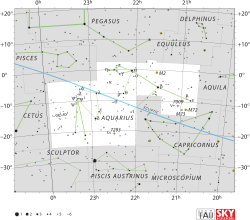53 Aquarii

| |
| Observation data Epoch J2000 Equinox J2000 | |
|---|---|
| Constellation | Aquarius |
| Right ascension | 22h 26m 34.2753s[1] |
| Declination | –16° 44′ 31.697″[1] |
| Apparent magnitude (V) | 5.56[2] (6.35/6.57)[3] |
| Characteristics | |
| Spectral type | G1 V + G5 V Fe–0.8 CH–1[4] |
| U−B color index | +0.09[2] |
| B−V color index | +0.61[2] |
| Astrometry | |
| Radial velocity (Rv) | +2.1[5] km/s |
| Proper motion (μ) | RA: +200.59[1] mas/yr Dec.: +14.51[1] mas/yr |
| Parallax (π) | 49.50 ± 1.23[1] mas |
| Distance | 66 ± 2 ly (20.2 ± 0.5 pc) |
| Absolute magnitude (MV) | 4.05[5] (4.94/4.87)[3] |
| Details | |
| 53 Aqr A | |
| Mass | 0.99[6] M☉ |
| Radius | 1.11[6] R☉ |
| Luminosity | 1.39[6] L☉ |
| Surface gravity (log g) | 4.46[3] cgs |
| Temperature | 5,922[3] K |
| Metallicity [Fe/H] | –0.10[3] dex |
| Rotational velocity (v sin i) | 8[7] km/s |
| Age | 0.18–0.37[8] Gyr |
| 53 Aqr B | |
| Surface gravity (log g) | 4.44[3] cgs |
| Temperature | 5,811[3] K |
| Metallicity [Fe/H] | –0.19[3] dex |
| Rotational velocity (v sin i) | 9[7] km/s |
| Other designations | |
| 53 Aqr A: BD–17 6521, HD 212698, HR 8545, LTT 9026, SAO 165078. | |
| 53 Aqr B: BD–17 6520, HD 212697, HR 8544, LTT 9025, SAO 165077. | |
53 Aquarii (abbreviated 53 Aqr) is a binary star[10] system in the equatorial constellation of Aquarius. 53 Aquarii is its Flamsteed designation though the star also bears the Bayer designation of f Aquarii. The combined apparent visual magnitude of the pair is a 5.56,[2] making it just visible to the naked eye in dark suburban skies. Based upon an annual parallax shift of 49.50 milliarcseconds for the first component, this system is located at a distance of approximately 65 light-years (20 parsecs) from Earth.[1]
This is a wide binary star system with a projected separation of 100 astronomical units; indicating that the two stars are at least this distance apart.[6] The primary component is a solar-type main sequence star with a stellar classification of G1 V.[4] It has about 99% of the Sun's mass, 111% of the Sun's radius, and shines with 139% of the luminosity of the Sun.[6] This energy is being emitted from an outer envelope at an effective temperature of 5,922 K,[3] giving it the golden hue of a G-type star.[11] An examination of the primary component with the Spitzer space telescope failed to detect any infrared excess that might otherwise be an indication of a circumstellar debris disk.[6]
The companion is a slightly cooler star with an effective temperature of 5,811 K.[3] It has a stellar classification of G5 V Fe–0.8 CH–1,[4] indicating it is a chemically peculiar G-type main sequence star showing an under-abundance of iron and the molecule CH in its spectrum. As of 2008, it has an angular separation of 1.325 arcseconds along a position angle of 30.9° from the primary.[12]
This system is coeval with the Castor Moving Group of stars that share a common motion through space; hence it is a candidate member of that association. This suggests that the system is young; its estimated age is in the range of 180 to 370 million years, based upon the spectrum and X-ray luminosity, respectively.[8]
References
- 1 2 3 4 5 6 van Leeuwen, F. (November 2007), "Validation of the new Hipparcos reduction", Astronomy and Astrophysics, 474 (2): 653–664, arXiv:0708.1752
 , Bibcode:2007A&A...474..653V, doi:10.1051/0004-6361:20078357.
, Bibcode:2007A&A...474..653V, doi:10.1051/0004-6361:20078357. - 1 2 3 4 Nicolet, B. (1978), "Photoelectric photometric Catalogue of homogeneous measurements in the UBV System", Astronomy and Astrophysics Supplement Series, 34: 1–49, Bibcode:1978A&AS...34....1N.
- 1 2 3 4 5 6 7 8 9 10 Pasquini, L.; Liu, Q.; Pallavicini, R. (July 1994), "Lithium abundances of nearby solar-like stars", Astronomy and Astrophysics, 287 (1): 191–205, Bibcode:1994A&A...287..191P.
- 1 2 3 Gray, R. O.; et al. (July 2006), "Contributions to the Nearby Stars (NStars) Project: Spectroscopy of Stars Earlier than M0 within 40 parsecs: The Northern Sample I", The Astronomical Journal, 132 (1): 161–170, arXiv:astro-ph/0603770
 , Bibcode:2006AJ....132..161G, doi:10.1086/504637.
, Bibcode:2006AJ....132..161G, doi:10.1086/504637. - 1 2 Nordström, B.; et al. (May 2004), "The Geneva-Copenhagen survey of the Solar neighbourhood. Ages, metallicities, and kinematic properties of ˜14 000 F and G dwarfs", Astronomy and Astrophysics, 418: 989–1019, arXiv:astro-ph/0405198
 , Bibcode:2004A&A...418..989N, doi:10.1051/0004-6361:20035959.
, Bibcode:2004A&A...418..989N, doi:10.1051/0004-6361:20035959. - 1 2 3 4 5 6 Plavchan, Peter; et al. (June 2009), "New Debris Disks Around Young, Low-Mass Stars Discovered with the Spitzer Space Telescope", The Astrophysical Journal, 698 (2): 1068–1094, arXiv:0904.0819
 , Bibcode:2009ApJ...698.1068P, doi:10.1088/0004-637X/698/2/1068.
, Bibcode:2009ApJ...698.1068P, doi:10.1088/0004-637X/698/2/1068. - 1 2 Torres, C. A. O.; et al. (December 2006), "Search for associations containing young stars (SACY). I. Sample and searching method", Astronomy and Astrophysics, 460 (3): 695–708, arXiv:astro-ph/0609258
 , Bibcode:2006A&A...460..695T, doi:10.1051/0004-6361:20065602.
, Bibcode:2006A&A...460..695T, doi:10.1051/0004-6361:20065602. - 1 2 Maldonado, J.; et al. (October 2010), "A spectroscopy study of nearby late-type stars, possible members of stellar kinematic groups", Astronomy and Astrophysics, 521: A12, arXiv:1007.1132
 , Bibcode:2010A&A...521A..12M, doi:10.1051/0004-6361/201014948.
, Bibcode:2010A&A...521A..12M, doi:10.1051/0004-6361/201014948. - ↑ "53 Aqr -- Double or multiple star", SIMBAD Astronomical Object Database, Centre de Données astronomiques de Strasbourg, retrieved 2012-07-14. See also the children entries.
- ↑ Eggleton, P. P.; Tokovinin, A. A. (September 2008). "A catalogue of multiplicity among bright stellar systems". Monthly Notices of the Royal Astronomical Society. 389 (2): 869–879. arXiv:0806.2878
 . Bibcode:2008MNRAS.389..869E. doi:10.1111/j.1365-2966.2008.13596.x.
. Bibcode:2008MNRAS.389..869E. doi:10.1111/j.1365-2966.2008.13596.x. - ↑ "The Colour of Stars", Australia Telescope, Outreach and Education, Commonwealth Scientific and Industrial Research Organisation, December 21, 2004, retrieved 2012-01-16.
- ↑ Tokovinin, A.; Cantarutti, R. (February 2008), "First Speckle Interferometry at SOAR Telescope with Electron-Multiplication CCD", Publications of the Astronomical Society of the Pacific, 120 (864): 170–177, Bibcode:2008PASP..120..170T, doi:10.1086/528809.